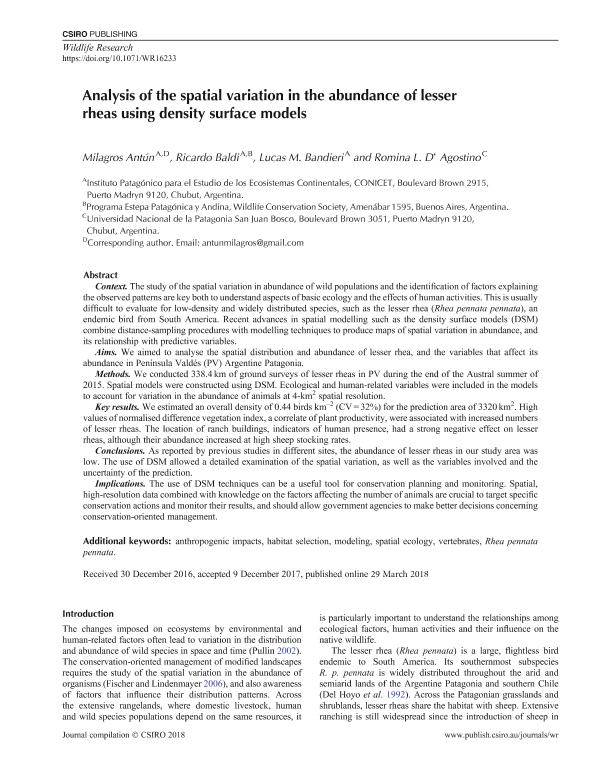Artículo
Analysis of the spatial variation in the abundance of lesser rheas using density surface models
Fecha de publicación:
03/2018
Editorial:
Csiro Publishing
Revista:
Wildlife Research
ISSN:
1035-3712
Idioma:
Inglés
Tipo de recurso:
Artículo publicado
Clasificación temática:
Resumen
Context: The study of the spatial variation in abundance of wild populations and the identification of factors explaining the observed patterns are key both to understand aspects of basic ecology and the effects of human activities. This is usually difficult to evaluate for low-density and widely distributed species, such as the lesser rhea (Rhea pennata pennata), an endemic bird from South America. Recent advances in spatial modelling such as the density surface models (DSM) combine distance-sampling procedures with modelling techniques to produce maps of spatial variation in abundance, and its relationship with predictive variables. Aims: We aimed to analyse the spatial distribution and abundance of lesser rhea, and the variables that affect its abundance in Península Valdés (PV) Argentine Patagonia. Methods: We conducted 338.4 km of ground surveys of lesser rheas in PV during the end of the Austral summer of 2015. Spatial models were constructed using DSM. Ecological and human-related variables were included in the models to account for variation in the abundance of animals at 4-km2 spatial resolution. Key results: We estimated an overall density of 0.44 birds km–2 (CV = 32%) for the prediction area of 3320 km2. High values of normalised difference vegetation index, a correlate of plant productivity, were associated with increased numbers of lesser rheas. The location of ranch buildings, indicators of human presence, had a strong negative effect on lesser rheas, although their abundance increased at high sheep stocking rates. Conclusions: As reported by previous studies in different sites, the abundance of lesser rheas in our study area was low. The use of DSM allowed a detailed examination of the spatial variation, as well as the variables involved and the uncertainty of the prediction. Implications: The use of DSM techniques can be a useful tool for conservation planning and monitoring. Spatial, high-resolution data combined with knowledge on the factors affecting the number of animals are crucial to target specific conservation actions and monitor their results, and should allow government agencies to make better decisions concerning conservation-oriented management.
Archivos asociados
Licencia
Identificadores
Colecciones
Articulos(IPEEC)
Articulos de INSTITUTO PATAGONICO PARA EL ESTUDIO DE LOS ECOSISTEMAS CONTINENTALES
Articulos de INSTITUTO PATAGONICO PARA EL ESTUDIO DE LOS ECOSISTEMAS CONTINENTALES
Citación
Antun, Maria de Los Milagros; Baldi, Ricardo; Bandieri, Lucas Martín; D´Agostino, Romina Laura; Analysis of the spatial variation in the abundance of lesser rheas using density surface models; Csiro Publishing; Wildlife Research; 45; 1; 3-2018; 47-54
Compartir
Altmétricas




